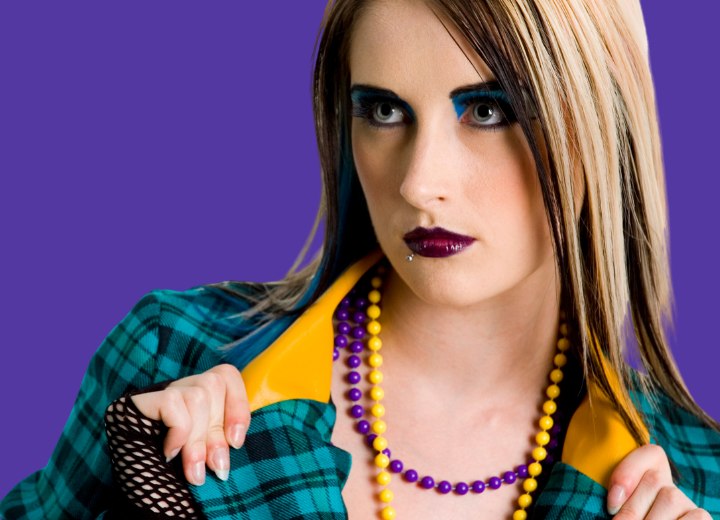Scene Hair (2)

Color:
Perhaps the biggest difference between Scene Hair and the Emo look is the use of color. While Emo looks generally prefer darker, more subdued hair colors, Scene hair typically incorporates enhancements and colorful accents into the look. For example, many Scene hair looks that start with a dark-colored base will include bold streaks of color (red, pink, blue, etc.) in the nape or fringe areas.
Those with naturally blonde or lighter hair may use the same bold colorful stripes or choose to add dark panels underneath the hair. Some looks even incorporate patterns dyed into the surface of the hair. If you don't want to color the hair, you can achieve the addition of color by using "clip-in" extension pieces.
A lot of the inspiration for the Scene Look comes from the standards set by Emo fashion sensibility. The hair is always choppy, shaggy, and the accessories are more extreme. Scenester kids typically opt for gauged ear piercings over the multiple-ladder type, choose false eyelashes over mascara, and always find the skinniest jeans they can squeeze into in the loudest colors and patterns possible.
According to those who claim to be in the know, "Scene is about the music." However, the internet is packed with "How to Be Scene" blogs and sites whose content is virtually identical, with step-by-step instructions and lists of what to buy, wear, and do to be "scene." They all emphasize being "original" and are more than happy to tell you how to achieve that.
How to cut the Basic Scene Girl’s Haircut:
The basic scene girl's haircut is a long-layered style that features choppy layers and bold streaks of color. To create this look, start with the seven-section parting (which is especially crucial when dealing with long hair) or simply divide the hair into upper, middle, and lower sections to secure it for working in sections.

The top layers of the hair, at the top and around the parietal ridge, should be lifted to a 180-degree elevation and then cut straight across to create the "long-layered" look. Once the upper portions are cut, re-secure the hair and leave down a lock on each side and in the back to serve as a guide for the side and middle back cuts.
These mid-level layers should be cut by lifting the hair to a 90-degree elevation and cutting the layers vertically. Make the lengths here about an inch longer than the guide you left hanging from the upper sections. For long faces or really thick hair, you may need to divide the middle layers into two separate stages and cut the lower half of the middle section longer than the upper half. Do what you feel provides the best balance for the cut.
The lower stage of the hair is held to a 45-degree elevation and cut perpendicular to the hair's position. If the hair is very thick, you can divide this lower portion into two stages and create steeper layering. Just make sure to cut the upper half of this lower stage at an angle to balance things.
Once all the layers are completed, texture the hair by using a point-cutting technique to create choppiness in the layers. Simply hold the hair away from the scalp segment by segment and point the scissors inward toward the scalp, cutting the hair into points. The shallower the angle, the choppier the look will appear. Steeper angles will create a finer-grained texture in the finished style.
©Hairfinder.com